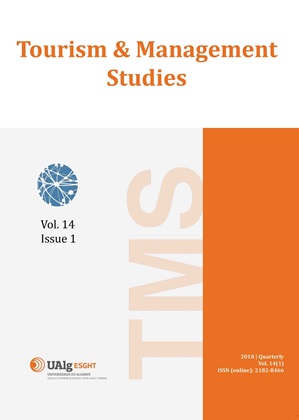Tourism destination competitiveness: an application model for the south of Portugal versus the Mediterranean region of Spain: COMPETITIVTOUR
Keywords:
Tourism Destination, Competitiveness, Territory Management, Evaluation Models, West Mediterranean CoastAbstract
Tourism destination competitiveness analysis benefits from a growing number of theoretical and applied developments. To support competitiveness strategies and despite the paraphernalia of competitiveness indexes available, there is not just a single set of indicators that can be used for all destinations at all times. The COMPETITIVTOUR model, developed since 2009 is applied to the south of Portugal versus the Mediterranean regions of Spain, a geographical area that aggregates 14 provinces, 20.2 million inhabitants and 180.1 million overnight stays. COMPETITIVTOUR’s objective is to create and apply a territorial assessment model, adapted to the common specificities of these regions, aiming to assist in guiding the complex task of destination competiveness management, with inputs from 25 official producers of information from Portugal and Spain. The outputs are aggregated in three main topics: territory management, markets, and resources&products. Critical areas were identified, with emphasis on the growing seasonality of demand, the market demand and supply adjustment and accommodation prices.
References
Ayikoru, M. (2015) Destination competitiveness challenges: A Ugandan perspective. Tourism Management, 50, 142–158.
Bornhorst, T., Ritchie, R. & Sheehan, L. (2010). Determinants of tourism success for DMO & destinations: An empirical examination of stakeholders’ perspectives. Tourism Management, 31, 572 – 589.
Buhalis, D. (2000). Marketing the competitive destination of the future, Tourism Management, 21, 97 – 116.
Chien-Minn C., Sheu-Hua, C., Hong-Tau, L. & Tsung-Hsien, T. (2016) Exploring destination resources and competitiveness–A comparative analysis of tourists' perceptions and satisfaction toward an island of Taiwan. Ocean & Coastal Management, 119, 58–67.
Croes, R. & Kubickova, M. (2013). From potential to ability to compete: Towards a performance-based tourism competitiveness index. Journal of Destination Marketing & Management, 2, 146 – 154.
Croes, R. (2011). Measuring and explaining competitiveness in the context of small island destinations. Journal of Travel Research, 50(4), 431 – 442.
Crouch, G. & Ritchie, J. (1999). Tourism, competitiveness, and social prosperity. Journal of Business Research, 44, 137 – 152.
Crouch, G. & Ritchie, J. (2000). A model of destination competitiveness/sustainability: Brazilian perspectives. Revista de Administração Pública, 44(5), 1049 – 1066.
Crouch, G. (2011). Destination competitiveness: An analysis of determinant attributes. Journal of Travel Research, 50(1), 27 – 45.
D’Hauteserre, A. (2000). Lessons in managed destination competitiveness: The case of Foxwoods casino resort. Tourism Management, 21, 23 – 32.
Dupeyras, A. & MacCallum, N. (2013). Indicators for measuring competitiveness in tourism: A guidance document, OECD Tourism Papers 2013/02, OECD Publishing.
Dwyer, L. & Kim, C. (2003). Destination competitiveness: Determinants and indicators. Current Issues in Tourism, 6(5), 369 – 414.
Dwyer, L., Dragi?evi?, V., Armenski, T., Mihali?, T. & Cvelbar, L. (2014). Achieving destination competitiveness: an importance-performance analysis of Serbia. Revista de Administração Pública, 44(5), 1049 – 1066.
Dwyer, L., Forsyth, P. & Rao, P. (2000). The price competitiveness of travel and tourism: A comparison of 19 destinations. Tourism Management, 21, 9 – 22.
Enright, M. & Newton, J. (2004). Tourism destination competitiveness: a quantitative approch. Tourism Management, 25, 777 – 788.
Go, F. & Govers, R. (2000). Integrated quality management for tourist destinations: A European perspective on achieving competitiveness. Tourism Management, 21, 79 – 88.
Hanafiah, M., Hemdi, M. & Ahmad, I. (2015) Reflections on Tourism Destination Competitiveness (TDC) Determinants. Advanced Science Letters, 21(5), 1571-1574.
Hassan, S. (2000). Determinants of market competitiveness in an environmentally sustainable tourism industry. Journal of Travel Research, 38, 239 – 245.
Huang, J. & Peng, K. (2012). Fuzzy Rasch model in TOPSIS: A new approach for generating fuzzy numbers to assess the competitiveness of the tourism industries in Asian countries. Tourism Management, 33, 456 – 465.
IMPACTUR – Indicadores de onitorização e Previsão da Atividade Turística (2015). Retrieved January 15th 2015, from http://www.impactur.pt.
Instituto Nacional de Estadística – España (2016). Retrieved January 15th 2015, from www.ine.es.
Instituto Nacional de Estatística – Statistics Portugal (2016). Retrieved January 15th 2015, from www.ine.pt.
Kayar, Ç. & Kozak, N. (2010). Measuring destination competitiveness: an application of the travel and tourism competitiveness index. Journal of Hospitality Marketing & Management., 19, 203 – 216.
Kozak, M. & Rimmington, M. (1999). Measuring tourist destination competitiveness: Conceptual considerations and empirical findings. Hospitality Management, 18, 273 – 283.
Mazanec, J. & Ring, A. (2011). Tourism destination competitiveness: Second thoughts on the World Economic Forum reports. Tourism Economics, 17(4), 725 – 751.
OECD (2005). OECD Annual Report – 45th anniversary, Paris: OECD.
Porter, M. (1980). Competitive strategy: Techniques for analyzing industry and competitors. New York: Free Press.
Porter, M. (1990). The competitive advantage of nations. London: the Macmillan Press ltd.
Sánchez, A. & Lopéz, D. (2015). Tourism destination competitiveness: the Spanish Mediterranean case. Tourism Economics, 21(6), 1235–1254.
Webster, C. & Ivanov, S. (2014). Transforming competitiveness into economic benefits: Does tourism stimulate economic growth in more competitive destinations. Tourism Management, 40, 137 – 140.
WEF – The World Economic Forum (2015) Retrieved January 15th 2015, from http://www.weforum.org/.
World Economic Forum (2007). The Travel & Tourism competitiveness report 2007: Furthering the process of economic development, Geneva, World Economic Forum.
Zhang, H., Gu, C., Gu, L. & Zhang, Z. (2011). The evaluation of tourism destination competitiveness by TOPSIS & information entropy – A case in the Yangtze River Delta of China. Tourism Management, 32, 443 – 451.
Downloads
Published
Issue
Section
License
Copyright (c) 2018 Tourism & Management Studies

This work is licensed under a Creative Commons Attribution-NoDerivatives 4.0 International License.
The journal retains published articles’ copyrights, but they are simultaneously licensed under the Creative Commons Attribution License (CC BY-NC-ND), which allows individuals’ to share the relevant papers as long as authorship and publication in this journal are duly acknowledged.



